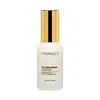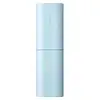What's inside
What's inside
 Key Ingredients
Key Ingredients

 Benefits
Benefits

 Concerns
Concerns

 Ingredients Side-by-side
Ingredients Side-by-side

Water
Skin ConditioningIsoamyl Laurate
Emollient1,2-Hexanediol
Skin ConditioningIsopentyldiol
HumectantInositol
HumectantGlycerin
HumectantInulin
Skin ConditioningArginine
MaskingDipalmitoyl Hydroxyproline
Skin ConditioningHyaluronic Acid
HumectantSodium Hyaluronate
HumectantThymus Vulgaris Flower/Leaf Extract
MaskingHoney Extract
HumectantPropolis Extract
Skin ConditioningRoyal Jelly Extract
Skin ConditioningSh-Polypeptide-123
Skin ProtectingCurcuma Longa Root Extract
MaskingDiisostearyl Malate
EmollientMaltooligosyl Glucoside
Skin ConditioningPropanediol
SolventBis-Diglyceryl Polyacyladipate-1
EmollientHydrogenated Starch Hydrolysate
HumectantGlycogen
HumectantCeratonia Siliqua Gum
EmollientMelia Azadirachta Leaf Extract
Skin ConditioningSodium Phytate
Melia Azadirachta Flower Extract
Skin ConditioningCorallina Officinalis Extract
Skin ConditioningCellulose
AbsorbentFructose
HumectantGlucose
HumectantOcimum Basilicum Flower/Leaf Extract
TonicOrmenis Multicaulis Oil
MaskingOcimum Sanctum Leaf Extract
Skin ConditioningAroma
Arachidyl Alcohol
EmollientCitrus Aurantium Amara Flower Extract
RefreshingBehenyl Alcohol
EmollientSclerotium Gum
Emulsion StabilisingArachidyl Glucoside
EmulsifyingCellulose Gum
Emulsion StabilisingCetearyl Alcohol
EmollientLecithin
EmollientLimonene
PerfumingLinalool
PerfumingXanthan Gum
EmulsifyingWater, Isoamyl Laurate, 1,2-Hexanediol, Isopentyldiol, Inositol, Glycerin, Inulin, Arginine, Dipalmitoyl Hydroxyproline, Hyaluronic Acid, Sodium Hyaluronate, Thymus Vulgaris Flower/Leaf Extract, Honey Extract, Propolis Extract, Royal Jelly Extract, Sh-Polypeptide-123, Curcuma Longa Root Extract, Diisostearyl Malate, Maltooligosyl Glucoside, Propanediol, Bis-Diglyceryl Polyacyladipate-1, Hydrogenated Starch Hydrolysate, Glycogen, Ceratonia Siliqua Gum, Melia Azadirachta Leaf Extract, Sodium Phytate, Melia Azadirachta Flower Extract, Corallina Officinalis Extract, Cellulose, Fructose, Glucose, Ocimum Basilicum Flower/Leaf Extract, Ormenis Multicaulis Oil, Ocimum Sanctum Leaf Extract, Aroma, Arachidyl Alcohol, Citrus Aurantium Amara Flower Extract, Behenyl Alcohol, Sclerotium Gum, Arachidyl Glucoside, Cellulose Gum, Cetearyl Alcohol, Lecithin, Limonene, Linalool, Xanthan Gum
Water
Skin ConditioningButylene Glycol
HumectantDipropylene Glycol
HumectantGlycerin
HumectantSqualane
Emollient1,2-Hexanediol
Skin ConditioningAmmonium Acryloyldimethyltaurate/Vp Copolymer
Propanediol
SolventCarbomer
Emulsion StabilisingCetearyl Alcohol
EmollientTromethamine
BufferingPolyglyceryl-3 Methylglucose Distearate
EmulsifyingDextrin
AbsorbentHydrogenated Lecithin
EmulsifyingEthylhexylglycerin
Skin ConditioningParfum
MaskingGlyceryl Stearate Citrate
EmollientDisodium EDTA
Betaine
HumectantHydrolyzed Hyaluronic Acid
HumectantBeta-Glucan
Skin ConditioningXylitylglucoside
HumectantAnhydroxylitol
HumectantXylitol
HumectantLactobacillus Ferment Lysate
Skin ConditioningGlucose
HumectantTocopherol
AntioxidantMagnesium Chloride
Tetradecyl Aminobutyroylvalylaminobutyric Urea Trifluoroacetate
Skin ConditioningUndaria Pinnatifida Extract
Skin ConditioningWater, Butylene Glycol, Dipropylene Glycol, Glycerin, Squalane, 1,2-Hexanediol, Ammonium Acryloyldimethyltaurate/Vp Copolymer, Propanediol, Carbomer, Cetearyl Alcohol, Tromethamine, Polyglyceryl-3 Methylglucose Distearate, Dextrin, Hydrogenated Lecithin, Ethylhexylglycerin, Parfum, Glyceryl Stearate Citrate, Disodium EDTA, Betaine, Hydrolyzed Hyaluronic Acid, Beta-Glucan, Xylitylglucoside, Anhydroxylitol, Xylitol, Lactobacillus Ferment Lysate, Glucose, Tocopherol, Magnesium Chloride, Tetradecyl Aminobutyroylvalylaminobutyric Urea Trifluoroacetate, Undaria Pinnatifida Extract
 Reviews
Reviews

Ingredients Explained
These ingredients are found in both products.
Ingredients higher up in an ingredient list are typically present in a larger amount.
1,2-Hexanediol is a synthetic liquid and another multi-functional powerhouse.
It is a:
- Humectant, drawing moisture into the skin
- Emollient, helping to soften skin
- Solvent, dispersing and stabilizing formulas
- Preservative booster, enhancing the antimicrobial activity of other preservatives
Cetearyl alcohol is a mixture of two fatty alcohols: cetyl alcohol and stearyl alcohol. It is mainly used as an emulsifier. Emulsifiers help prevent the separation of oils and products. Due to its composition, it can also be used to thicken a product or help create foam.
Cetearyl alcohol is an emollient. Emollients help soothe and hydrate the skin by trapping moisture.
Studies show Cetearyl alcohol is non-toxic and non-irritating. The FDA allows products labeled "alcohol-free" to have fatty alcohols.
This ingredient is usually derived from plant oils such as palm, vegetable, or coconut oils. There is debate on whether this ingredient will cause acne.
Due to the fatty acid base, this ingredient may not be Malassezia folliculitis safe.
Learn more about Cetearyl AlcoholGlucose is a simple sugar and is the most important source of energy in all organisms.
In skincare, glucose is used to hydrate the skin. It also acts as a prebiotic for our natural biome.
Glucose is hydrating due to its humectant property. As a humectant, glucose draws moisture from the air and from deeper levels in the skin.
Our skin contains many sugars that act as prebiotics and help strengthen our natural microbiome. Having a healthy microbiome helps protect our skin from harmful bacteria and other contaminants.
Studies show glucose may help with fading discoloration and pigmentation. This is because our skin metabolizes glucose into lactic acid. Lactic acid is an AHA that helps exfoliate the top layer of skin.
Learn more about GlucoseGlycerin is already naturally found in your skin. It helps moisturize and protect your skin.
A study from 2016 found glycerin to be more effective as a humectant than AHAs and hyaluronic acid.
As a humectant, it helps the skin stay hydrated by pulling moisture to your skin. The low molecular weight of glycerin allows it to pull moisture into the deeper layers of your skin.
Hydrated skin improves your skin barrier; Your skin barrier helps protect against irritants and bacteria.
Glycerin has also been found to have antimicrobial and antiviral properties. Due to these properties, glycerin is often used in wound and burn treatments.
In cosmetics, glycerin is usually derived from plants such as soybean or palm. However, it can also be sourced from animals, such as tallow or animal fat.
This ingredient is organic, colorless, odorless, and non-toxic.
Glycerin is the name for this ingredient in American English. British English uses Glycerol/Glycerine.
Learn more about GlycerinPropanediol is an all-star ingredient. It softens, hydrates, and smooths the skin.
It’s often used to:
Propanediol is not likely to cause sensitivity and considered safe to use. It is derived from corn or petroleum with a clear color and no scent.
Learn more about PropanediolWater. It's the most common cosmetic ingredient of all. You'll usually see it at the top of ingredient lists, meaning that it makes up the largest part of the product.
So why is it so popular? Water most often acts as a solvent - this means that it helps dissolve other ingredients into the formulation.
You'll also recognize water as that liquid we all need to stay alive. If you see this, drink a glass of water. Stay hydrated!
Learn more about Water